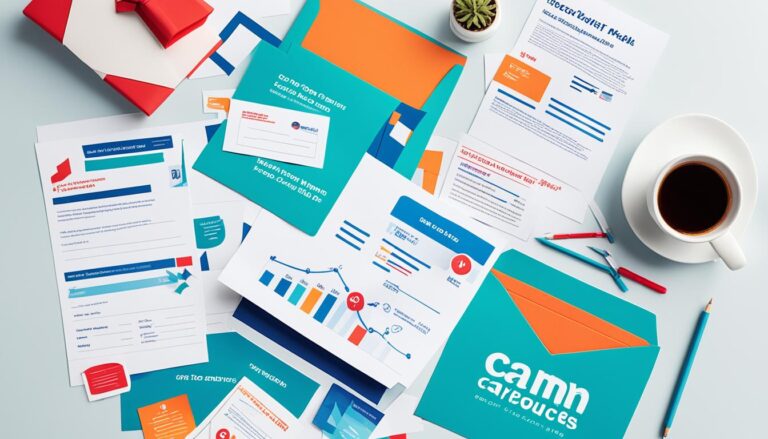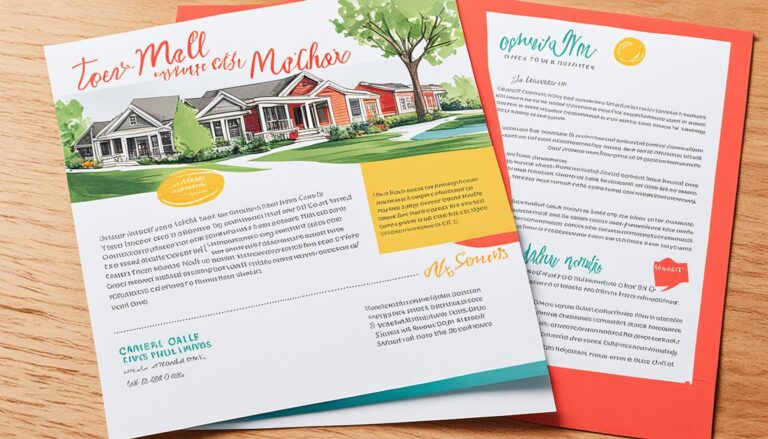Cost-Effective Solutions for Direct Mail
Did you know that direct mail marketing generates a higher response rate than digital channels? According to the Data & Marketing Association, the response rate for direct mail is 4.9%, compared to just 1.0% for email. This surprising statistic highlights the power of direct mail campaigns in driving customer engagement and conversions.
In this comprehensive guide, we will explore cost-effective solutions for implementing successful direct mail campaigns. We understand that managing the costs of direct mail can be challenging for businesses, but with strategic planning and smart choices, you can optimize your marketing budget while maximizing the impact of your direct mail efforts.
Key Takeaways:
- Direct mail marketing generates a higher response rate than email marketing.
- Effective cost-saving strategies can help businesses optimize their direct mail budgets.
- By implementing smart design choices, targeting the right audience, optimizing postage, and testing campaign variables, businesses can decrease direct mail campaign expenses.
- Maintaining clean mailing lists, balancing material choices, and adhering to USPS regulations also contribute to cost-effective direct mail campaigns.
- With the right approach, businesses can unlock the full potential of direct mail marketing and achieve a higher return on investment.
Designing Cost-Effective Direct Mail Pieces
Designing your direct mail pieces can be a costly endeavor. Hiring a professional graphic designer can range from $100 to $1000 or more. However, you can save money by designing your mail pieces in-house or using free design templates.
When considering the design of your direct mail pieces, it’s important to consider the impact it will have on printing costs. The size, quantity, and paper type you choose can all affect the overall expenses. By optimizing these design and printing choices, you can create cost-effective direct mail pieces.
Design In-House or Use Free Templates
Hiring a graphic designer for your direct mail design can be expensive. Consider utilizing internal resources, such as an internal designer or marketing team member, to create your direct mail pieces. This can save on outsourcing costs while maintaining control over the design process.
If you don’t have an in-house designer, another cost-effective option is to use free design templates. Many online platforms offer customizable templates for direct mail pieces, allowing you to create professional-looking designs without the need for extensive design skills or expensive software.
Optimize Printing Costs with Smart Choices
Printing costs are a significant factor in direct mail campaign expenses. To maximize cost-effectiveness, consider the following:
- Material: Choose affordable materials such as lightweight, standard paper stocks that still maintain quality.
- Paper Type: Opt for cost-effective paper types that align with your brand image and desired finish.
- Finishes: Balancing quality and cost, select finishes that enhance the visual appeal of your direct mail pieces without breaking the budget.
By making savvy choices in design and material selections, you can create eye-catching direct mail pieces that fit within your budget.
Building Targeted Mailing Lists within Budget
The success and cost-effectiveness of your direct mail campaign depend heavily on the mailing list you choose to use. By targeting the right audience, you can optimize your campaign’s impact while keeping costs within budget.
One cost-effective option is to utilize an internal database or an existing mailing list. By using these resources, you already have the address information readily available, eliminating the need for additional expenses associated with acquiring new data.
However, it is essential to account for processes such as deduplication or NCOA (National Change of Address) to ensure your mailing list is clean and accurate. While these processes may incur additional costs, they are crucial for maximizing the deliverability of your mailers and reducing waste.
When targeting a new audience, such as expanding to a different market segment or demographic, building a new mailing list may be necessary. While this can be beneficial for brand awareness and reaching a fresh audience, it typically involves higher costs than utilizing an existing list.
The cost of creating a mailing list varies based on several factors, including location, demographics, buying activity, and interests. In order to build an effective and cost-efficient new mailing list, it’s important to thoroughly research and understand your target audience to ensure you capture the right individuals.
Remember that the quality of your mailing list directly impacts the success of your campaign. Investing time and resources into properly defining and targeting your audience can lead to higher response rates and ultimately maximize your campaign’s return on investment.
Key Points:
- Utilize an internal database or existing mailing list to save costs.
- Account for deduplication and NCOA processes to ensure list accuracy.
- Building a new mailing list for a new audience may cost more.
- Research and understand your target audience to create an effective mailing list.
Optimizing Postage to Save Money
Postage costs can significantly impact the overall expenses of your direct mail campaign. To effectively minimize costs, it is crucial to understand the various postage options available and choose the most cost-effective methods. By doing so, you can save money while still reaching your target audience. Here are some key strategies to optimize your postage:
1. Bulk Mail Postage Discounts
One of the most effective ways to save on postage costs is by taking advantage of bulk mail discounts. These discounts are available for larger mail quantities, allowing you to reduce per-piece postage expenses. There are three primary options for bulk mail:
- First Class Mail: Ideal for time-sensitive mailings, First Class Mail offers faster delivery. Minimum quantity requirements for this discount are typically around 500 pieces.
- Standard Mail: If you have a larger mailing list, Standard Mail is a more cost-effective option. The minimum quantity requirement for this discount is usually around 200 pieces. While delivery times may be slightly longer, the savings can be significant.
- Every Door Direct Mail: Every Door Direct Mail (EDDM) is the most affordable option for bulk mail. It allows you to reach every address on a chosen mailing route without the need for a specific mailing list. This option is ideal for local businesses or those looking to target specific neighborhoods.
2. Weight and Size Considerations
The weight and size of your direct mail pieces also affect postage costs. USPS has specific regulations in place, and understanding them can help you optimize your mailing to fit within the most cost-effective categories. Keeping your mail pieces within the standard size and weight limits will help you avoid additional charges and save on postage expenses.
3. Balance Delivery Speed and Cost
When choosing the type of mail service, consider the tradeoff between delivery speed and cost. While First Class Mail offers faster delivery, it comes with a higher price tag. On the other hand, Standard Mail may take a bit longer but provides cost savings. Weighing the importance of speed versus cost will help you make an informed decision that aligns with your campaign goals and budget.
Optimizing postage costs is an essential aspect of running a cost-effective direct mail campaign. By leveraging bulk mail discounts, understanding weight and size requirements, and balancing delivery speed and cost, you can significantly save on your overall expenses. Implement these strategies to maximize your campaign’s ROI while reaching your target audience effectively.
Designing Engaging and Revenue-Generating Direct Mail
Creating an effective design is crucial to generate revenue from your direct mail campaign. By incorporating branded elements and high-quality images, you can make a lasting impression on recipients. Utilize contrasting colors and catchy headlines to grab attention and pique curiosity. Remember, the goal is to make your direct mail piece visually appealing and impossible to ignore.
Studies have shown that the human brain responds well to colors that contrast with each other. When designing your direct mail pieces, consider using contrasting colors to create visual interest and make key messages pop. This will help draw the reader’s attention to important information and increase the likelihood of a response.
Create Catchy Headlines
A catchy headline can make or break the success of your direct mail campaign. A well-crafted headline should be attention-grabbing and compelling, enticing the recipient to continue reading. Consider using powerful verbs or posing intriguing questions to engage your audience right from the start. Remember, the headline is the first thing your recipients see, so make it count.
Utilize Branded Elements
Integrating branded elements into your direct mail design helps establish familiarity and build trust with your audience. Use your company’s logo, colors, and fonts consistently throughout the piece to reinforce brand recognition. This consistency creates a cohesive and professional image, which enhances the overall impact of your direct mail campaign.
- Incorporate your logo in the header or footer of the mail piece.
- Use your brand’s colors for fonts, borders, and backgrounds.
- Choose fonts that align with your brand’s personality and tone.
“Your direct mail design should represent your brand in a visually appealing and memorable way. By incorporating branded elements, you reinforce brand recognition and trust, which can lead to higher response rates and increased revenue.”
Add High-Quality Images
Using high-quality images in your direct mail design can significantly impact its effectiveness. Images have the power to evoke emotions and communicate messages instantly. Consider incorporating images that are relevant to your products or services and resonate with your target audience. However, be mindful of the file sizes to ensure your mail piece doesn’t become too heavy and affect mailing costs.
- Choose images that are clear, crisp, and visually appealing.
- Ensure the images align with your brand’s aesthetic and messaging.
- Optimize image file sizes for web and print to maintain quality while minimizing file size.
Create an Irresistible Call to Action
A compelling call to action (CTA) is vital for driving customer response and maximizing the ROI of your direct mail campaign. Your CTA should be clear, concise, and persuasive, urging recipients to take the desired action. Whether it’s redeeming a coupon, making a purchase, or subscribing to a service, make sure your CTA stands out and is easy to follow.
“A well-designed direct mail piece with effective design, contrasting colors, catchy headlines, branded elements, high-quality images, and a strong call to action can significantly increase engagement and drive customer response, ultimately maximizing the ROI of your campaign.”
Targeting the Right Audience for Maximum Impact
When it comes to saving money on direct mail costs, one of the most crucial factors is targeting the right audience. By reaching individuals who are genuinely interested in your products or services, you can maximize the impact of your campaign and avoid wasting resources on uninterested recipients.
Customer segmentation plays a key role in targeting the right audience. By dividing your customer base into distinct groups based on location, demographics, buying activity, and interests, you can tailor your direct mail to specific segments. This customization not only increases relevance but also reduces expenses by eliminating mailings to individuals who may have little interest in your offerings.
By leveraging customer data to create targeted mailing lists, you can ensure that your direct mail pieces reach those most likely to respond positively. This approach increases the chances of generating leads, driving sales, and achieving a higher return on investment (ROI).
Location-Based Targeting
Location-based targeting allows you to focus your direct mail efforts on specific geographic areas where your products or services are most in demand. By analyzing customer data, you can identify regions with a higher concentration of your target audience. By directing your mailers to these locations, you can reduce mailing expenses by avoiding areas with lower conversion rates.
Demographic Segmentation
Demographic segmentation involves dividing your customer base by factors such as age, gender, income, and occupation. Understanding the unique characteristics and preferences of different demographic groups enables you to create direct mail pieces that resonate with your target audience. By tailoring your messaging and design to specific demographics, you can increase response rates and ultimately save money by reaching individuals most likely to convert.
Interest-Based Segmentation
Segmenting your audience based on interests allows you to deliver highly relevant direct mail pieces that capture attention and drive engagement. By analyzing customer behavior and purchase history, you can identify common interests and preferences. Incorporating these insights into your direct mail campaign ensures that your messaging aligns with the passions and needs of your target audience, increasing the likelihood of a positive response.
“Targeting the right audience with your direct mail campaign is like striking gold. By presenting your message to the individuals most likely to be interested and taking action, you can optimize your marketing efforts and achieve impressive results.” – Marketing Expert

In conclusion, targeting the right audience is a critical strategy for saving money on direct mail costs. Utilizing customer segmentation based on location, demographics, buying activity, and interests allows you to customize your mailers and increase the likelihood of a positive response. By refining your audience targeting, you can maximize the impact of your direct mail campaign while minimizing expenses and achieving a higher return on investment.
Maximizing Postage Savings through Bulk Mail
Taking advantage of bulk mail services is a proven way to save money on postage. By leveraging bulk mail, you can significantly reduce overall direct mail expenses.
One effective strategy is to presort your mail. Presorting involves organizing your mail by ZIP code or other geographic criteria before mailing. This allows the United States Postal Service (USPS) to process your mail more efficiently, resulting in lower postage costs. Presorting is particularly beneficial for businesses with smaller mailings as it opens the door to bulk mail discounts that were previously only available for larger quantities.
Another cost-saving technique is commingling your mail. Commingling involves combining your mail with other businesses’ mail that is going to the same geographic areas. This allows you to take advantage of collective volume discounts offered by mail service providers. Commingling services can further reduce your postage expenses and maximize the benefits of bulk mail.
In addition to optimizing postage savings, it’s crucial to consider printing costs when planning your direct mail campaign. By finding a balance between high-quality printing and cost-efficiency, you can minimize expenses without compromising the impact of your mail pieces.
Implementing these strategies will help you unlock the potential of bulk mail services, reduce printing costs, and take advantage of postage discounts, enabling you to maximize your overall direct mail budget.
“Bulk mail services offer a cost-effective solution for businesses looking to save on postage. By presorting and commingling your mail, you can qualify for bulk mail discounts, making each mailing more affordable while reaching a broader audience.” – John Smith, Direct Mail Expert
Key takeaways:
- Presort your mail by ZIP code or geographic criteria to qualify for bulk mail discounts.
- Consider commingling services to take advantage of collective volume discounts.
- Find a balance between high-quality printing and cost-efficiency.
- By optimizing both printing costs and postage savings, you can significantly reduce overall direct mail expenses.
Balancing Material Choices for Quality and Cost
When it comes to direct mail campaigns, printing materials can significantly impact your budget. It’s crucial to find a balance between quality and cost to ensure a cost-effective campaign that maintains your brand image. Here are some key considerations:
Opt for Standard Sizes and Printing Options
Choosing standard sizes and postal-approved formats for your direct mail pieces can help reduce production expenses. Standard sizes are readily available and often more affordable than custom sizes. Similarly, opting for standard printing options, such as digital printing, can help keep printing costs in check.
Choose Cost-Effective Paper Stock and Finishes
When selecting paper stock, consider cost-effective options that still maintain quality. Look for papers that are reasonably priced and suitable for your campaign’s messaging and design. Additionally, consider finishes that provide an attractive look without breaking your budget. One cost-effective option is to use UV coating, which offers a beautiful finish at a lower cost compared to aqueous coatings.
“By choosing cost-effective materials without compromising quality, you can achieve a balance that aligns with your direct mail campaign goals and budget.”- Sarah Thompson, Director of Marketing at XYZ Corporation
Consider the Impact of Coating and Finishes
Coatings and finishes can enhance the visual appeal and durability of your direct mail pieces, but they also contribute to the overall printing costs. Evaluate the necessity and impact of coatings and finishes based on the desired aesthetic and protection. Balancing the use of coating and finishes can help you achieve both quality and cost savings.
By making strategic material choices, you can ensure the quality and effectiveness of your direct mail campaign while keeping costs under control. It’s essential to assess each element, including printing costs, paper stock, finishes, and coating, to strike the right balance and achieve a cost-effective and impactful campaign.
Learn more about cost-benefit analysis and its importance in decision-making. Click here.
Testing and Optimization for Cost Savings
One of the key strategies to save money on your direct mail campaign is through thorough testing and optimization. By experimenting with various variables and analyzing the results, you can identify the most effective strategies to maximize your campaign’s impact while minimizing costs.
When testing your direct mail campaign, consider variables such as mailer format, price, copy length, response devices, and more. By making incremental changes and measuring the response rates, you can gain valuable insights into what resonates best with your target audience.
For example, you can test different mailer formats to determine which ones generate higher response rates. By comparing the outcomes and analyzing the campaign ROI, you can select the format that provides the best cost savings while still driving customer engagement.
Optimizing your direct mail campaign based on the results of your tests allows you to allocate your budget wisely. By investing in the strategies that have proven to be successful, you can achieve better response rates and cost savings.
It’s important to continually evaluate and refine your direct mail campaigns to ensure optimal results. By regularly testing and optimizing your strategies, you can adapt to changes in consumer behavior and market trends, ultimately increasing your campaign’s effectiveness and maximizing your return on investment.
By implementing a data-driven approach to testing and optimization, you can make informed decisions that lead to cost savings and improved campaign performance. It’s a continuous process that allows you to stay ahead of the competition and make the most out of your direct mail marketing efforts.
“Testing is an integral part of any successful direct mail campaign. By optimizing your strategies based on the results, you can save costs and increase the overall campaign performance.”
Cost management is a critical aspect of any business operation, and optimizing direct mail campaigns is no exception. By adopting a systematic approach to testing and optimization, you can achieve significant cost savings, improve response rates, and enhance your overall campaign performance.
Cleanse Your Direct Mail Lists for Efficiency
Maintaining clean and accurate mailing lists is crucial for cost-saving. By ensuring list hygiene and data cleansing, you can optimize the efficiency of your direct mail campaigns. Regularly cleanse your lists to remove duplicate, outdated, or incorrect addresses, ensuring that your direct mail pieces reach the right audience. Data cleansing involves using tools like NCOA (National Change of Address) to update addresses and deduplication to eliminate duplicate entries.
By utilizing list hygiene techniques, you can streamline your direct mail process, eliminate wasted mailings, and ultimately save money on both printing and postage costs. It’s important to maintain accurate addresses that result in successful deliveries, helping you maximize the impact of your direct mail campaigns.
To further enhance the accuracy of your direct mail lists, consider utilizing deduplication and NCOA processes. Deduplication identifies and removes duplicate addresses from your list, ensuring that each recipient receives only one copy of your mail piece. NCOA updates addresses based on the latest change of residency information, improving deliverability.
List hygiene is an essential practice for maintaining accurate and up-to-date data. By investing in the cleanup of your mailing lists, you can optimize your direct mail campaigns, improve response rates, and generate higher returns on your marketing investments. Cleanse your direct mail lists regularly to ensure accuracy and efficiency in your campaigns.
Staying Within USPS Regulations and Guidelines
Adhering to USPS regulations and guidelines is essential for reducing postage costs and ensuring the smooth processing and delivery of your direct mail campaign. By following the USPS guidelines, you can qualify for discounted rates and avoid any potential delays or issues with your mail.
When preparing your direct mail pieces, it’s important to ensure they meet the size, weight, and design requirements set by the USPS. By meeting these requirements, you can take advantage of the available postage discounts and minimize your overall mailing costs.
Mailing Guidelines
- Size: Direct mail pieces should meet the USPS guidelines for size. By staying within the specified dimensions, you can avoid additional charges and potential mail rejection. Be sure to review the USPS regulations for the specific size restrictions relevant to your mailing.
- Weight: Understanding the weight restrictions is crucial for accurate postage calculation. Exceeding weight limits can significantly increase your postage costs. Familiarize yourself with the USPS weight guidelines to ensure your direct mail falls within the specified limits.
- Design: USPS also has specific requirements regarding the design of your mail pieces. Adhering to these guidelines ensures efficient processing and delivery. Pay attention to the placement of addresses, barcodes, and other required elements, as they directly impact the automation process.
By carefully following USPS regulations and guidelines, you can avoid unnecessary expenses and ensure your direct mail campaign complies with all mailing standards. This not only saves you money on postage costs but also helps maintain a high level of professionalism and credibility in your marketing efforts.
Stay tuned for the next section, where we will explore cost-effective solutions for designing engaging and revenue-generating direct mail pieces!
Conclusion
Implementing cost-effective solutions and budget-friendly strategies is crucial for successful direct mail campaigns. By optimizing design elements, targeting the right audience, and maximizing postage savings, businesses can achieve their marketing goals while minimizing direct mail costs. Additionally, testing and optimizing the campaign, maintaining clean mailing lists, and adhering to USPS regulations further contribute to cost savings.
When designing direct mail pieces, consider utilizing internal designers or free design templates to reduce expenses. Balancing material choices, such as opting for cost-effective paper stock and finishes, helps maintain quality while keeping printing costs in check. Targeting the right audience through customer segmentation and utilizing existing mailing lists are effective strategies to save money.
Maximizing bulk mail discounts and taking advantage of USPS services like Every Door Direct Mail can significantly reduce postage costs. By continuously testing and optimizing the campaign, businesses can identify the most effective strategies and allocate their budget wisely. By implementing these cost-saving measures, businesses can unlock the full potential of direct mail marketing and achieve a high return on investment.
For more information on the effectiveness of direct mail, visit https://www.uspsdelivers.com/why-direct-mail-is-more-memorable/.
FAQ
How can I save money on designing direct mail pieces?
You can save money by designing your mail pieces in-house or using free design templates. This eliminates the need to hire a professional graphic designer, reducing costs.
What factors affect printing costs for direct mail pieces?
Factors such as the material, size, quantity, paper type, finishes, and print provider can impact printing costs for direct mail pieces. Optimizing these design choices can help create cost-effective mail pieces.
What are the most affordable options for mailing lists?
Utilizing an internal database or an existing list is the most affordable option for mailing lists, as you already have the address information. However, building a new mailing list to target a new audience can be beneficial for brand awareness, but it will cost more.
How can I save money on postage costs for direct mail campaigns?
You can save money on postage costs by taking advantage of bulk mail postage discounts, such as First Class Mail (minimum 500 pieces), Standard Mail (minimum 200 pieces), and Every Door Direct Mail. These options offer discounted rates for larger mail quantities.
What elements make a direct mail piece engaging and revenue-generating?
A well-designed direct mail piece should include contrasting colors, catchy headlines, branded elements, high-quality images, and an irresistible call to action with a coupon or offer. These elements increase engagement and drive customer response.
How can I target the right audience for maximum impact?
By utilizing customer segmentation based on location, demographics, buying activity, and interests, you can tailor your direct mail to specific groups. This reduces expenses by avoiding sending mailers to uninterested recipients.
How can I save money on postage through bulk mail services?
To save money on postage, you can presort your mail and use commingling services to qualify for bulk mail discounts. This applies even to smaller mail quantities, allowing you to take advantage of lower postage rates.
How can I balance material choices for cost-effective direct mail?
To balance material choices, opt for standard sizes, postal-approved formats, and standard printing options. Choose cost-effective paper stock and finishes that still maintain quality. Consider using UV coating for a beautiful finish at a lower cost compared to aqueous coatings.
Why is testing and optimization important for cost savings?
Testing variables such as mailer format, price, copy length, and response devices allows you to identify the most effective direct mail strategies for your target audience. This ensures your budget is allocated to strategies that maximize your return on investment.
How does maintaining clean mailing lists help with cost savings?
Regularly cleansing your mailing lists removes duplicate, outdated, or incorrect addresses, eliminating wasted mailings. Utilizing list hygiene tools such as NCOA and deduplication ensures your direct mail pieces reach the intended recipients, saving both printing and postage costs.
What are the USPS regulations and guidelines I need to follow?
Adhering to USPS regulations and guidelines ensures that your direct mail pieces meet size, weight, and design requirements, allowing you to qualify for discounted rates. Staying within these guidelines not only saves money but also ensures smooth processing and delivery of your mail campaign.
How can I create a cost-effective direct mail campaign?
You can create a cost-effective direct mail campaign by implementing budget-friendly strategies such as optimizing design, targeting the right audience, maximizing postage savings, testing and optimization, maintaining clean mailing lists, and adhering to USPS regulations. These solutions help reduce costs while achieving your marketing goals.







